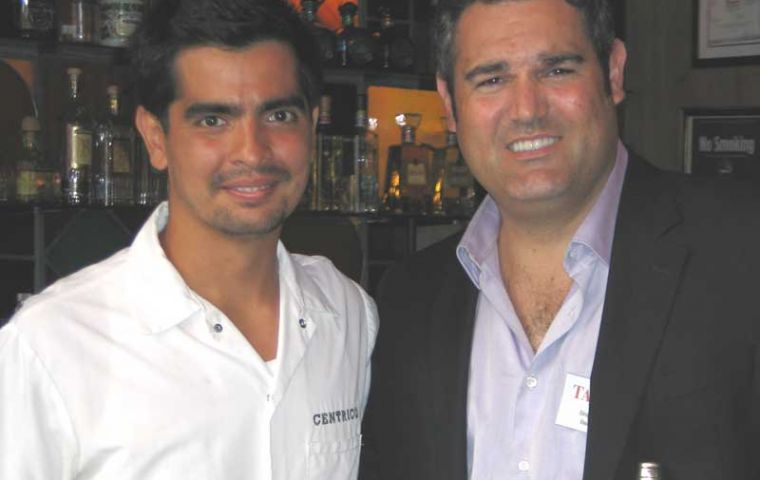MercoPress. South Atlantic News Agency
“The Great Uruguayan Tannat Tasting, New York”
 Chef Aaron Sanchez & Brian DiMarco (BarterHouse/Bouza Wines)
Chef Aaron Sanchez & Brian DiMarco (BarterHouse/Bouza Wines) “Uruguay's wine industry, particularly Tannat, received ample praise from New York City's gourmets and media during the recent Fourth Annual Great Tannat Tasting.”
The fourth annual Great Tannat Wine Tasting in New York City welcomed the media and industry trade to discover the taste of Tannat, as well as many other more familiar grape varieties that are planted throughout the regions of Uruguay. Too often the unfamiliar in the wine industry is branded as "new" – in fact, while the aromas, tastes and flavors of Uruguay may be new to many, the wineries represented today have a noble history, in many cases dating back several generations. Each winery has a unique story to tell, and a distinct philosophy to viticulture and winemaking which attendees were encouraged to discover. Tannat may be a grape that has its history in France, but it has truly emerged on the world's stage as a foundation of Uruguayan winemaking, where it achieves an appealing level of ripeness and tannin balance. Tannat is renowned for its high tannin content, intense color and full flavor. On the palate, it imparts spicy notes, lush fruit, cherry-berry accents, rich texture and a lingering finish. Tannat reaches its greatest potential when it is paired with meat and complex dishes. This is one grape that is not afraid of a little spice or heat! This year's Tannat tasting was presented with the inspired cuisine of Chef Aarón Sanchez of Centrico Restaurant. Chef Sanchez Develops a Taste for TannatChef Aarón Sanchez is the Executive Chef of Centrico Restaurant, and America's next Iron Chef. Hosting Uruguayan winemakers for the 4th Annual Great Tannat Tasting, he stated, "I enjoy Uruguayan wines and have offered them in my restaurant. Uruguay is making high quality wines with entirely unique taste attributes, essential criteria which we look for in selecting wines at Centrico. In our recent tasting of Tannat wines the robust varietal character really came through, although each winery has also imprinted their signature style on their wines. I was also pleasantly surprised by the superior quality of Uruguayan white wines. Uruguay really is a rising star in South America and needs to be taken seriously for Tannat wines and more! When it comes to food pairings, the flavor profile of Tannat wines offers considerable versatility. It works with more traditional dishes, as well as more complex recipes. Guests at this Great Tannat Tasting are able to sample both styles. For example, I have prepared Beef Anticuchos with Mint-Almond Mojo (grilled skewered beef with Mint-Almond gravy) and Rollitos de Filet Mignon con Jicama y Salsa de Queso Cabrales (Filet Mignon rollitos with a yam bean and a blue cheese sauce.) I have been using Uruguayan meat for several years. It's very lean and packed with flavors that work beautifully with my cooking style. The cattle in Uruguay are grass fed and naturally raised so they have access to clean air and pure water – all of which contributes to the quality of the meat. This same respect for the natural environment, in my opinion, is also what sets the wines apart." When MercoPress asked him which Uruguayan wines did he think are the best quality, without pause Chef Sanchez replied, "Bouza." Winemaking Essentials − TANNAT, Symbol of URUGUAYWinemaking has been practiced in Uruguay for over 250 years. In 1870, the fathers of modern winemaking in Uruguay – Don Pascual Harriague and Don Francisco Vidiella – first introduced the French Tannat and Folle Noire varietals; Tannat has been the preferred "noble" grape of Uruguay ever since. Ideally suited to the local terroir, Tannat yields intense, powerful wines with varied characteristics ranging from rustic to elegant, always captivating, and with an unmistakable identity. Tannat creates wines of distinction with great body and tannic structure, and with intense color and aromatic finesse. Considerable care is taken to source premium Tannat grapes at optimum states of maturity, and to showcase the variety's complex fruit. The grape is also well-suited to blends, particularly with classic grape varieties such as Cabernet and Merlot. There are no restrictions on the type of varietal plantings in any region. Tannat is planted in every region. 73% of planted varieties are red, composed of Tannat (25%) plus Merlot, Cabernet Sauvignon, Cabernet Franc, and Syrah as the primary red varieties. 27% of planted varieties are white - Sauvignon Blanc, Chardonnay and Viognier are the primary varieties. Uruguay – Background and History- 3.2 million people - 43.8 million acres - Diverse European-based culture - 1825 – Declaration of Independence: Republic of Uruguay created Uruguay is a relatively small Latin American country. Situated between Argentina, Brazil and the Atlantic Ocean, Uruguay lies at the gateway to South America. The country's ideal geographic situation combined with strengths in banking and communications, have established Uruguay as a major exporting country in South America. Uruguay has a free economy backed by excellent international trading relations and investment incentives. In the last two decades, this small export driven economy has come back from economic stagnation to become one of the most politically, economically and socially stable countries in Latin America, with a strong investment environment. Strategically positioned, Uruguay has long been an important point of entry to the region and a center for regional trade, resulting in an open, cosmopolitan society. For more information contact the Uruguayan American Chamber of Commerce in the United States at: gateway@uruguaychamber.com




Top Comments
Disclaimer & comment rulesCommenting for this story is now closed.
If you have a Facebook account, become a fan and comment on our Facebook Page!